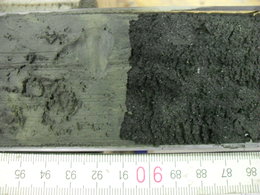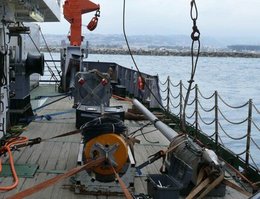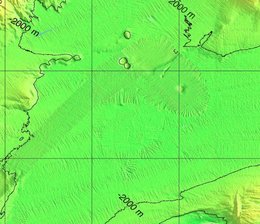Page path:
- Home
- Research
- Seafloor Dynamics
- Completed projects
- former SD projects (2013 - 2017)
- SD3 Key Hypotheses
SD3 Key Hypotheses
Both the mineralogical composition (i.e. high clay content) and consolidation state of continental margin deposits control the location and mechanics of failure.
The role of distinctive textures and frictional strength on slope stability and failure mechanisms will be studied on a micro- (i.e. particle) level. This will employ a combined approach of in-situ tests, geotechnical laboratory experiments, and numerical modeling focusing on the role of layering and failure surface roughness on deformation styles. Because the physical properties of slope sediments control both initial failure and the transport mechanisms of mass-wasting events, we will quantify crucial physical properties, such as peak strength, friction coefficient, cohesion, consolidation state and permeability of slope sediments at the pre- and post-failure stages. Light will be shed on failure plane geometry, transport length and mechanism, etc., by utilizing a largescale numerical model simulating a generic, continuously steepened slope that will be compared to observations in nature.
The role of distinctive textures and frictional strength on slope stability and failure mechanisms will be studied on a micro- (i.e. particle) level. This will employ a combined approach of in-situ tests, geotechnical laboratory experiments, and numerical modeling focusing on the role of layering and failure surface roughness on deformation styles. Because the physical properties of slope sediments control both initial failure and the transport mechanisms of mass-wasting events, we will quantify crucial physical properties, such as peak strength, friction coefficient, cohesion, consolidation state and permeability of slope sediments at the pre- and post-failure stages. Light will be shed on failure plane geometry, transport length and mechanism, etc., by utilizing a largescale numerical model simulating a generic, continuously steepened slope that will be compared to observations in nature.

Multi-parameter long-term observations are the only means for reliably identifying and distinguishing between the short-term triggers of landslides in areas where multiple drivers for slope failure prevail.
The stability of marine sediments at ocean margins is a function of the intrinsic strength of the material and the forces counteracting this strength, most prominently pore pressure. This relationship, known as the effective stress (Hubbert and Rubey, 1959), is a crucial aspect in slope stability, since pore pressures may equal the overburden stress, exceed lithostatic values, and hence cause liquefaction (in coarse-grained sediment) or softening (in fine-grained material) by destroying the particle network. Both non-destructive soft-sediment deformation (creeping, slumping, liquefaction) and brittle failure (faulting, hydrofracture) are important processes in mass wasting along continental slopes, and both occur over long timescales (cf. Locat and Lee, 2002). Other factors, such as groundwater intrusion, seismic shaking, or rapid sediment accumulation may also act as triggers (Stegmann et al. 2011). The diversity of such processes will be unambiguously identified using in-situ measurements of strain, fluid flow, electrical conductivity, seismicity or turbidity.
The stability of marine sediments at ocean margins is a function of the intrinsic strength of the material and the forces counteracting this strength, most prominently pore pressure. This relationship, known as the effective stress (Hubbert and Rubey, 1959), is a crucial aspect in slope stability, since pore pressures may equal the overburden stress, exceed lithostatic values, and hence cause liquefaction (in coarse-grained sediment) or softening (in fine-grained material) by destroying the particle network. Both non-destructive soft-sediment deformation (creeping, slumping, liquefaction) and brittle failure (faulting, hydrofracture) are important processes in mass wasting along continental slopes, and both occur over long timescales (cf. Locat and Lee, 2002). Other factors, such as groundwater intrusion, seismic shaking, or rapid sediment accumulation may also act as triggers (Stegmann et al. 2011). The diversity of such processes will be unambiguously identified using in-situ measurements of strain, fluid flow, electrical conductivity, seismicity or turbidity.

The driving mechanisms of fluid-flow in deep-seated mud volcanoes and diapirs are similar to those triggering slope failure, i.e., pore pressure transients from geoprocesses.
Like submarine landslides, mud volcanic eruptions are instantaneous, rapid and externally driven. Submarine mud domes may cause the formation or destruction of small islands, harm ecosystems, or (in case of diatremes and pockmarks) release of large amounts of free gas into the water column (e.g. Dimitrov, 2002; Kopf, 2002). At the same time, the material extruding at the surface provides a “window into depth”, and reveals information that is otherwise inaccessible to direct sampling because it originates several kilometers below the seafloor. We will use sedimentological and petrophysical as well as geotechnical techniques to assess the depth of origin of the solid-phase mud volcano products to reconstruct the driving mechanisms and evolution (Fig. SD4). Via CCP5 (see below) this work will be linked to Research Area GB where porewater and gas chemistry will be analyzed, and gas flux quantified. Fig. SD4: Example of a mud volcano on the Mediterranean Ridge accretionary complex, including potential sources for fluids ([1] fluid expulsion from compaction, [2] biogenic methane, [3] fluid migration along faults, [4] mineral dehydration reactions, [5] thermogenic methane and higher hydrocarbons). The episodic nature and driving mechanisms of such features will be studied in detail in SD3 and CCP4 (Kopf, 2002, 2008).
Like submarine landslides, mud volcanic eruptions are instantaneous, rapid and externally driven. Submarine mud domes may cause the formation or destruction of small islands, harm ecosystems, or (in case of diatremes and pockmarks) release of large amounts of free gas into the water column (e.g. Dimitrov, 2002; Kopf, 2002). At the same time, the material extruding at the surface provides a “window into depth”, and reveals information that is otherwise inaccessible to direct sampling because it originates several kilometers below the seafloor. We will use sedimentological and petrophysical as well as geotechnical techniques to assess the depth of origin of the solid-phase mud volcano products to reconstruct the driving mechanisms and evolution (Fig. SD4). Via CCP5 (see below) this work will be linked to Research Area GB where porewater and gas chemistry will be analyzed, and gas flux quantified. Fig. SD4: Example of a mud volcano on the Mediterranean Ridge accretionary complex, including potential sources for fluids ([1] fluid expulsion from compaction, [2] biogenic methane, [3] fluid migration along faults, [4] mineral dehydration reactions, [5] thermogenic methane and higher hydrocarbons). The episodic nature and driving mechanisms of such features will be studied in detail in SD3 and CCP4 (Kopf, 2002, 2008).



